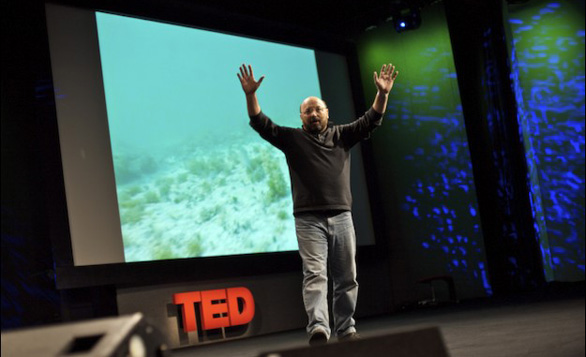 Underwater, there’s a world full of the bioluminescent and colorfully firework-like creatures.
Underwater, there’s a world full of the bioluminescent and colorfully firework-like creatures.
 David Gallo: Underwater astonishments
This is what David Gallo showed us in his classic talk from TED2007, “Underwater astonsihments.” The most interesting part: We have only explored about 3% of the world’s oceans, Gallo explains and, in this talk, he shares some views of that fascinating fraction with us.
David Gallo: Underwater astonishments
This is what David Gallo showed us in his classic talk from TED2007, “Underwater astonsihments.” The most interesting part: We have only explored about 3% of the world’s oceans, Gallo explains and, in this talk, he shares some views of that fascinating fraction with us.
Today’s TED Weekends on the Huffington Post delves into the aquatic, inspired by Gallo’s talk. Below, find essays to kindle thought on our ocean world.
.
David Gallo: What you don’t know about life at the bottom of the ocean
I had the privilege of spending a few days with Jim Cameron recently. Most people know Jim as the person who created the two highest grossing films (Avatar and Titanic) in Hollywood history. Few know him as a recognized leader in ocean exploration and a true ocean champion. Among other things, he’s earned that reputation by his development of new technologies, by his unparalleled exploration of RMS Titanic, and most recently by his 7-mile solo dive to the very deepest spot on planet Earth. Jim Cameron respects the ocean as much as any environmentalist and he knows it as well as any scientist.
I’d say his love of the sea runs as deep as his dive. Jim is quick to point out that he has surrounded himself with a very talented team that has become used to setting an incredibly high bar for the rest of the world. During my visit with Jim he said something to me about the sea that stopped me in my tracks. We were discussing the inability to effectively convey the importance of the ocean to humanity and vice versa. Jim said, “The oceans are changing faster than we can understand them.”
Think about that. Read the full essay »
David Helvarg: Restoring the Blue
We’ve mapped less than 10 percent of the ocean with the resolution we’ve mapped 100 percent of the Moon and Mars, and yet when we send rovers to Mars what’s the first sign of life they probe for? Water. David Gallo’s ‘Underwater Astonishments’ reminds us of how little we know about our own blue marble planet and the 97 percent of its livable habitat that is saltwater. Remember that we air-breathing terrestrials only inhabit about 300 feet of space from prairie dog burrows to the tops of the trees where birds nest. Above that is only heaven and space.
Hundreds of people have now gone into space, calling it “the last frontier,” but last year Jim Cameron became only the third human being ever to reach the lowest point on our planet, seven miles down in the Pacific’s Challenger Deep. Here in the early 21st century we’re just beginning to fully discover our ocean planet’s unique alien creatures — walking sharks, vampire squid, deep-sea coral gardens and hydrothermal vents awash with life even as we put them at risk. Every time I go diving, I discover something new and wondrous — and too often signs of human disruption. Read the full essay »
Mario Livio: A Grand Cosmic Evolution
In his TED Talk, David Gallo shows some absolutely amazing sea creatures, of breathtaking shapes and colors. But the deep ocean is not the only place where we can marvel at the wonders of nature. The heavens are another such place, and the Hubble Space Telescope, in particular, has captured for us some images about which we can truly say that they are “out of this world.”
Take, for instance, the recently released image of the ring nebula. If we didn’t know any better, we might have guessed that we are looking at some exotic jellyfish, or sea anemone. Actually, this is a dying Sun-like star, that has ejected its outer layers at the stage when the star had already become a giant, allowing its hot central core to irradiate the expelled layer, causing them to fluoresce in bright colors. This star is at a distance of about 2000 light-years from us, and the nebula has a size of about 1 light-year across. Fascinatingly, even though this event represents stellar DEATH, the ejected gas from such dying stars enriches the interstellar medium with elements such as carbon, and those are later incorporated into new stars, planets, and indeed into life as we know it. Read the full essay »
Comments (2)